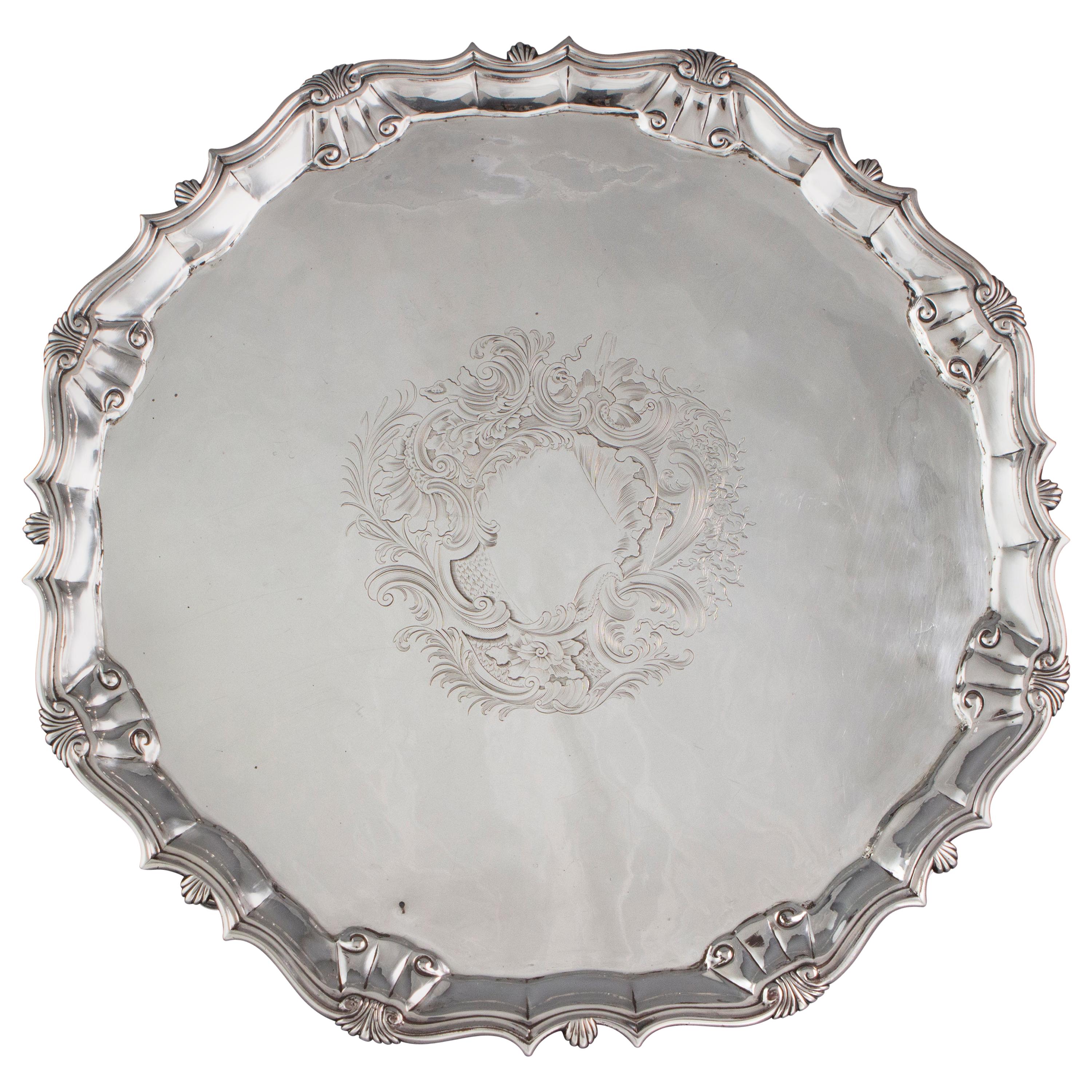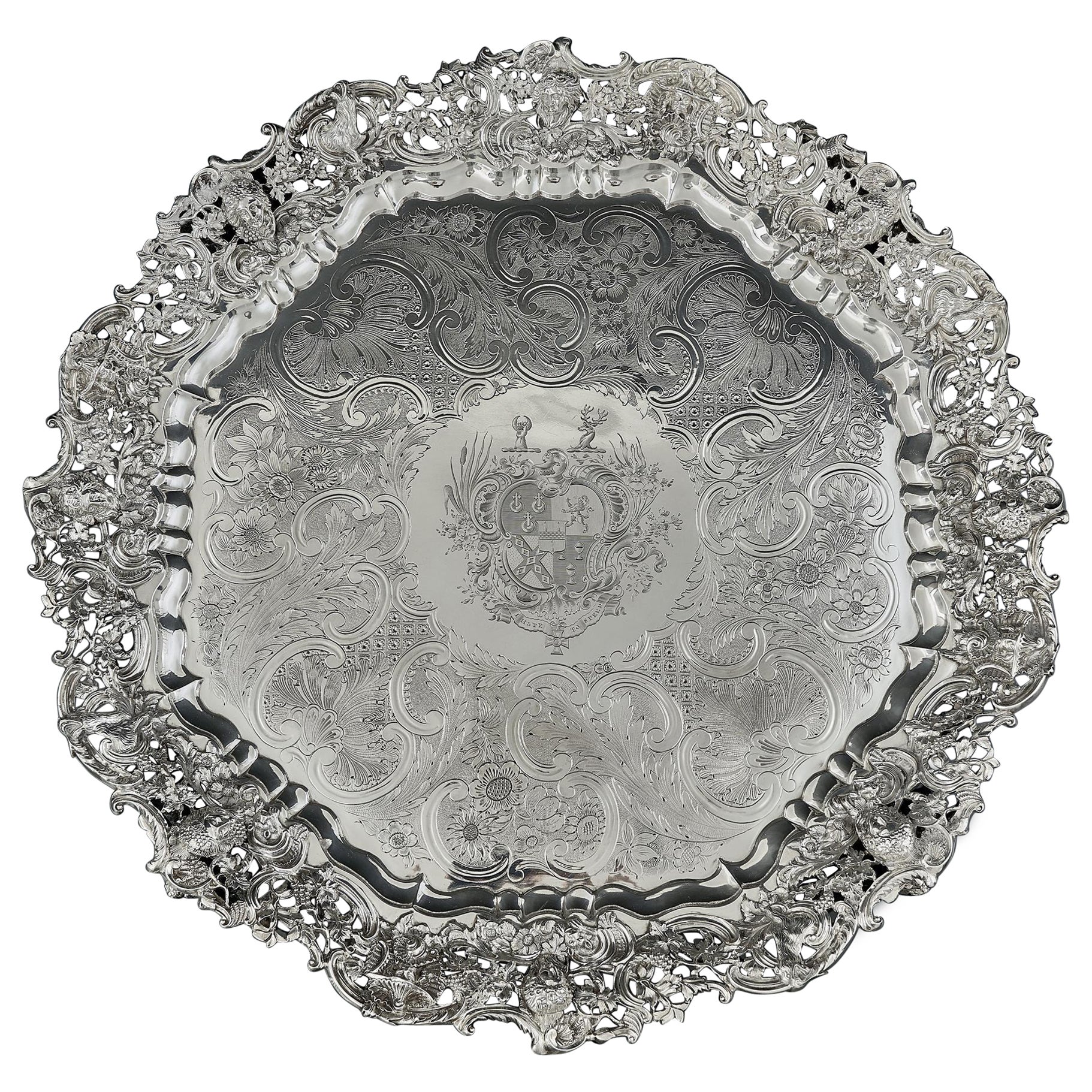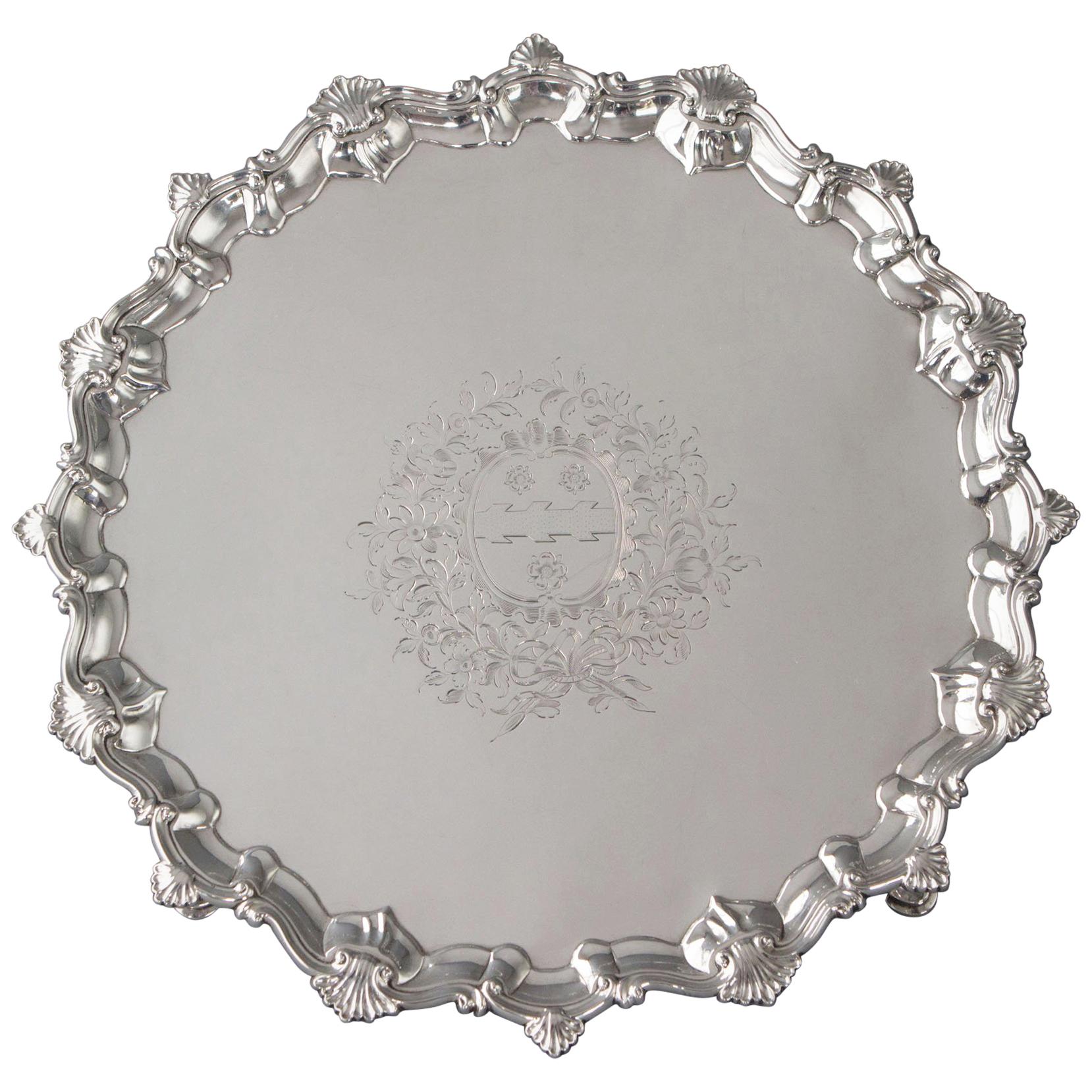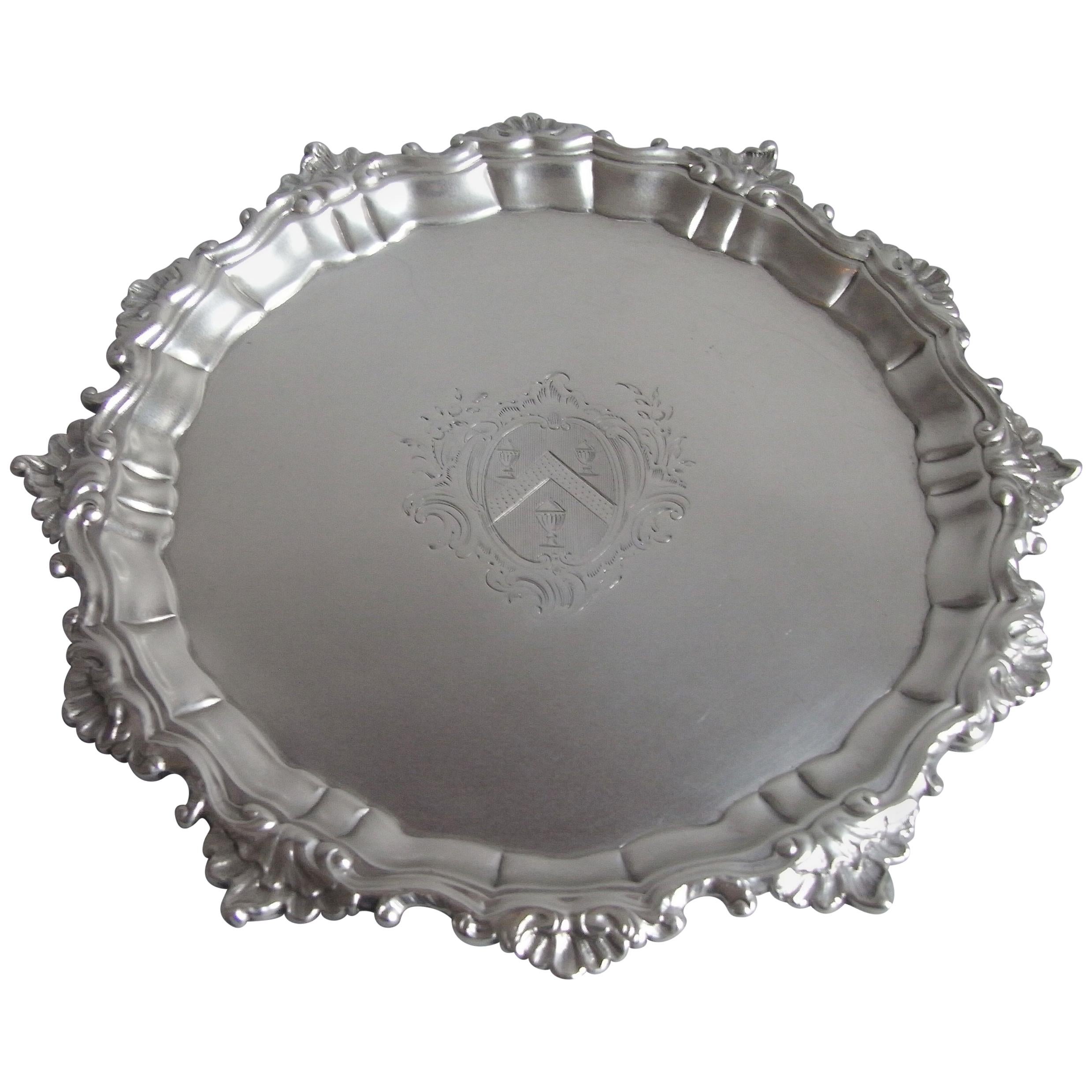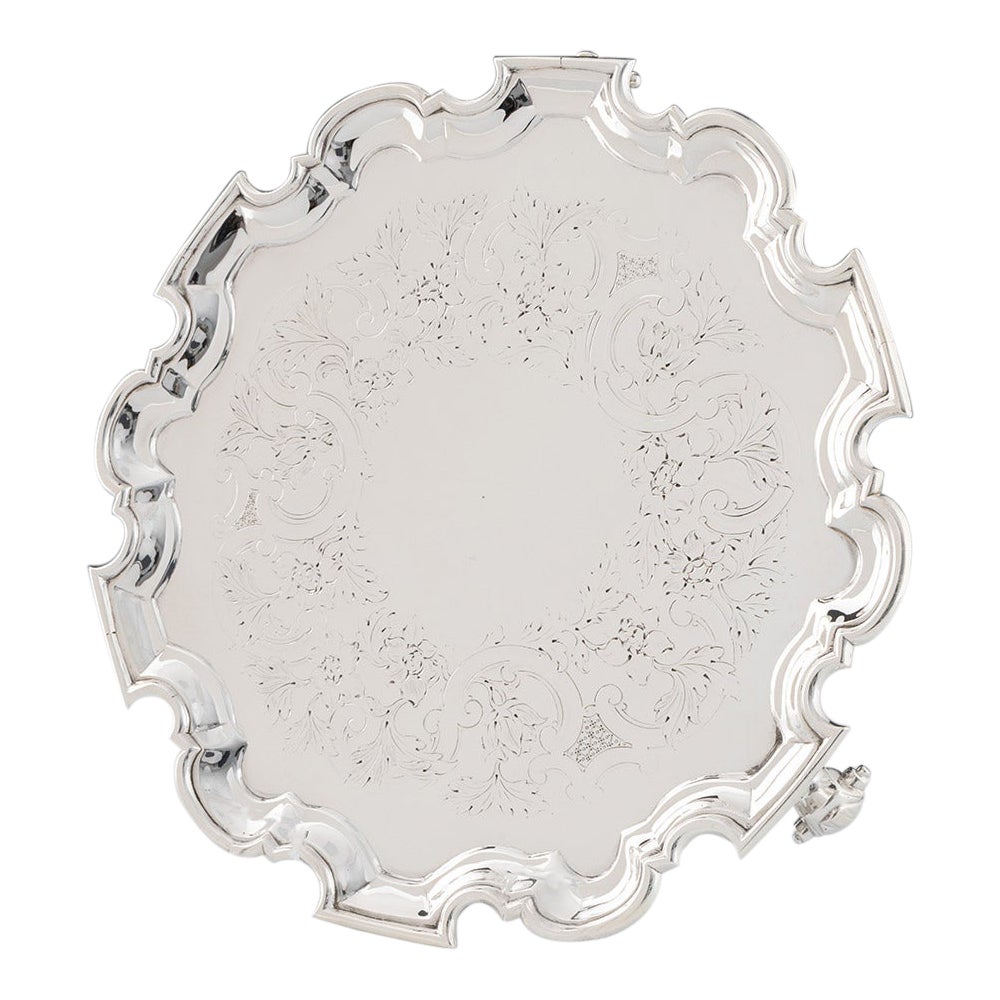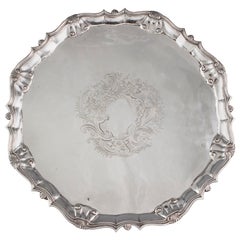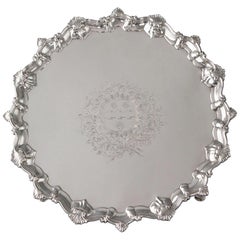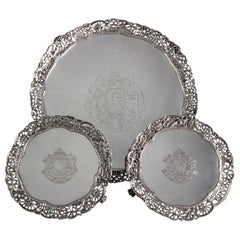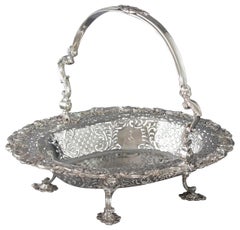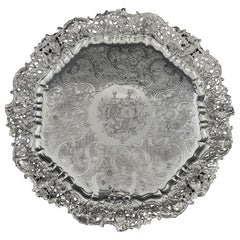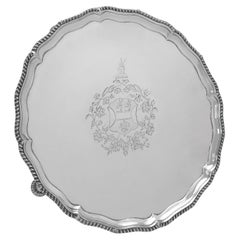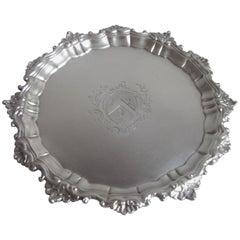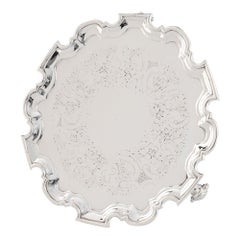Items Similar to Large George II Silver Salver London 1738 by John Tuite
Want more images or videos?
Request additional images or videos from the seller
1 of 9
Large George II Silver Salver London 1738 by John Tuite
$6,835.02
£5,000
€5,840.90
CA$9,531.10
A$10,444.72
CHF 5,454.45
MX$125,516.99
NOK 68,190.12
SEK 64,314.15
DKK 43,595.82
About the Item
A large and impressive George II octagonal silver salver with pie crust edge and shell decoration. The central plate engraved with cornucopia of fruits and flowers amidst patterned arabesques. The centre engraved with an armorial beneath a crown. The whole standing on four scrolling leaf capped feet.
Marked to the underside for London 1738 by specialist salver maker John Tuite.
This is a large and impressive early Georgian silver salver in absolutely original unrestored and undamaged condition. The decoration and armorial are obviously contemporary with the piece and as a result are slightly worn as are the undersides of the feet. The hallmarks are clearly struck and absolutely legible. The piece stand stands true on a tabletop and is of a wonderful color and patina.
Measures: Diameter 18.25 inches or 46 cm
Height 1.5 inches or 4 cm
Weight 2346 g or 82.7 oz or 75 ounces troy.
- Creator:John Tuite (Maker)
- Dimensions:Height: 1.58 in (4 cm)Diameter: 18.12 in (46 cm)
- Style:George IV (Of the Period)
- Materials and Techniques:
- Place of Origin:
- Period:1730-1739
- Date of Manufacture:1738
- Condition:Wear consistent with age and use.
- Seller Location:Cornwall, GB
- Reference Number:1stDibs: LU3939316842202
About the Seller
5.0
Vetted Professional Seller
Every seller passes strict standards for authenticity and reliability
Established in 2015
1stDibs seller since 2018
18 sales on 1stDibs
- ShippingRetrieving quote...Shipping from: Cornwall, United Kingdom
- Return Policy
Authenticity Guarantee
In the unlikely event there’s an issue with an item’s authenticity, contact us within 1 year for a full refund. DetailsMoney-Back Guarantee
If your item is not as described, is damaged in transit, or does not arrive, contact us within 7 days for a full refund. Details24-Hour Cancellation
You have a 24-hour grace period in which to reconsider your purchase, with no questions asked.Vetted Professional Sellers
Our world-class sellers must adhere to strict standards for service and quality, maintaining the integrity of our listings.Price-Match Guarantee
If you find that a seller listed the same item for a lower price elsewhere, we’ll match it.Trusted Global Delivery
Our best-in-class carrier network provides specialized shipping options worldwide, including custom delivery.More From This Seller
View AllLarge George II Silver Salver or Tray, London, 1750 by John Le Sage
By John Le Sage
Located in Cornwall, GB
A very fine George II silver salver or tray of large shaped circular form. A cast and applied shell and scroll gallery, with the plain central plate engraved with a vacant rocaille c...
Category
Antique 1750s English Georgian Platters and Serveware
Materials
Sterling Silver
George II Silver Salver, Richard Rugg, London, 1759
By Richard Rugg
Located in Cornwall, GB
An excellent silver salver with scrolling shell pattern rim and the whole resting on four hoof feet. The center engraved with an armorial. (see pictures) The armorial is surrounded b...
Category
Antique 1750s English George II Platters and Serveware
Materials
Sterling Silver
Set of 3 George III Silver Salvers or Trays, London 1762 by Richard Rugg
By Richard Rugg
Located in Cornwall, GB
A rare set of 3 early George III silver salvers or trays. Consisting of a large salver accompanied by two smaller salvers or waiters. All with intricately cast, pierced gallery borde...
Category
Antique 1760s English George III Sterling Silver
Materials
Sterling Silver
George II Sterling Silver Basket, London, 1747
By Edward Aldridge
Located in Cornwall, GB
A very good large silver swing handle basket of pierced oval form. The arched swing handle with two cast female busts arising from a leaf capped double C-scroll support. The cast and applied rim of shaped foliate and floral entwined decoration. The central bowl of the basket engraved with a rocaille cartouche containing an armorial. The top of the handle is decorated with a leaf form cartouche within which is the crest of a deer. The sides of the raised basket with hand cut pierced decoration. The whole standing on four cast and applied legs, decorated with a beautiful scrolling foliate design rising to high relief female faces, on leaf-form pad feet.
Hallmarked to the underside for London 1747 by Edward Aldridge. The underside of the handle bears the lion passant and maker’s mark, both struck twice.
This is a beautifully decorated and impressive piece of early Georgian silver...
Category
Antique 1740s British George II Sterling Silver
Materials
Sterling Silver
Royal Interest, a George II Silver Harvest Basket London 1759, by William Tuite
By William Tuite
Located in Cornwall, GB
A very large George II silver swing handle harvest basket by William Tuite. Of pierced oval form, adorned with an immaculately cast rim decorated with scrolls, wheat sheaves and grapes surrounding four putti collecting the harvest. Each of the eight pierced sections are framed by cascading harvest bounty. The arched, swing handle decorated with matching floral, wheat and grape decoration, supported either side by a cast putti...
Category
Antique 1750s British George II Sterling Silver
Materials
Sterling Silver
Speaker Smith, Political Interest: George III Silver Sauce Tureens, London, 1774
By Augustin Le Sage
Located in Cornwall, GB
An exquisite set of four George III silver oval two handled oval sauce tureens and covers. Of Oval bombe form on four rocaille capped scroll feet, with ovolo cast borders and handles...
Category
Antique 1770s British George III Serving Pieces
Materials
Sterling Silver
$34,175
Free Shipping
You May Also Like
Large antique George IV sterling silver salver
By Joseph Craddock 1
Located in London, GB
A superb quality antique silver salver or charger in the highly decorative rococo style. Made during the reign of George IV, this large silver salver has a cast openwork border fine...
Category
Antique 19th Century British George IV Platters and Serveware
Materials
Sterling Silver
George III period sterling silver salver by Ebeneezer Coker London 1771
By Ebenezer Coker
Located in London, London
Hallmarked in London in 1771 by Ebenezer Coker, this handsome, Antique, George III period, Sterling Silver Salver, stands on 4 flared feet, and features a shaped gadroon border, and ...
Category
Antique 1770s English George III Platters and Serveware
Materials
Sterling Silver
Good George II Salver Made in London in 1754 by Thomas Robinson
Located in London, GB
The Salver stands on three hoof feet and displays a raised shaped border decorated with scrolls and Rococo shell details. The centre of the Salver is engraved with a contemporary Arm...
Category
Antique 1750s English More Dining and Entertaining
George II Sterling Silver Salver London 1742
By Philip Garden
Located in Tunbridge Wells, GB
Heading : Geogian sterling silver salver with engraving
Date : Hallmarked in London in 1742 for Philip Garden
Period : George II
Origin : London, England
Decoration : Chippendale sty...
Category
Antique 1740s British George II Sterling Silver
Materials
Silver
Antique George III Sterling Silver Salver by Paul Storr 19th Century
By Paul Storr
Located in London, GB
This is a wonderful English antique George III sterling silver 10 inch salver, by the world famous silversmith Paul Storr.
It has clear hallmarks for London 1811 and the makers mark of Paul Storr.
It is typical of his work with the raised gadrooned rim with anthemion at intervals, on four fabulous foliate bracket feet. The salver is engraved with a crest and motto and the underside is later engraved
Charlotte J. Parke from C. J. Parke, March 1893'
The centre is engraved with a crest above a motto 'True and Fast' and I have researched this crest:
The Crest of Parke
The crest as engraved upon this George III English Sterling Silver Footed Salver by Paul Storr hallmarked London 1811 is that of the family of Parke. It may be blazoned as follows:
Crest: A stag’s head couped sable holding in the mouth a key or
Motto: True and fast
The family of Parke originally hailed from the County of Cumberland in the northeast of England1 later settling in the County of Dorset at Henbury House, Sturminster Marshal, near Wimborne. Given the evidence of the inscription found on the underside of the salver ‘Charlotte J. Parke from C. J. Parke, March 1893’ it was undoubtedly at one time in the possession of Charles Joseph Parke (died 9th March 1893) of Henbury House aforesaid and gifted to Charlotte Josephine Parke (baptised 4th January 1857 died 2nd January 1941) his third daughter by his wife, Ellen Mary Ethelston. I would venture the following hypothesis that the salver was bequeathed to Charlotte in her father’s will that was granted probate at London on the 20th May 1893. The ‘March 1893’ of the inscription acts as a remembrance of the month of the death of her father. It was noted that Charlotte’s father left an estate worth some £66,892, 19 shillings and one pence, a very considerable sum in the last decade of the 19th Century and even thereafter. Charlotte never married and was living at the time of her death at The Coppice, Sixpenny Handley in the County of Dorset. Her will was proved for probate at Llandudno on the 25th March 1941. She left an estate worth £18,866, 10 shillings and 4 pence. Again, a comfortable sum in 1941.
See the photo of Henbury House, Sturminster Marshal, near Wimborne, Co. Dorset. The former seat of the Parke family. The house was destroyed by fire, the remains of which were demolished in the 1990's.
There is no mistaking its unique quality and design, which is sure to make it a treasured piece by any discerning collector.
Condition:
In excellent condition with clear hallmarks and no dings, dents or signs of repair. Please see photos for confirmation.
Dimensions in cm:
Height 2 x Width 26.5 x Depth 26.5
Weight 0.69 kg
Dimensions in inches:
Height 1 inch x Width 10 inches x Depth 10 inches
Weight 1.5 lbs
Paul Storr
born in London England in 1771, was to become one of the most talented silversmiths of the nineteenth century. Today his legacy of exceptionally well crafted silver, found worldwide in museums and private collections, leaves one in awe when compared to that of his contemporaries.After having served a seven year apprenticeship from the age of 14, he began his career in 1792 when he went into a brief partnership with William Frisbee. This did not last and in 1793 a new mark, (his initials ‘P S’) was entered. By the beginning of the nineteenth century he had established himself as one of London’s top silversmiths producing, amongst others, commissions for Royalty.
In 1801 he married Elizabeth Susanna Beyer with whom he was to have ten children. In 1807 Paul Storr entered into a working relationship with Philip Rundell and by 1811 was a partner, and managing the workshops for Rundell, Bridge & Rundell.
During this period he kept his own marks and separate workshop. However it was through Rundell, Bridge & Rundell who were appointed Goldsmith in Ordinary to George III in 1804 that his reputation as a master silversmith grew. His talents lay in being able to transform ideas and designs from Rundell, Bridge & Rundell’s designers, William Theed...
Category
Antique 1810s English George III Sterling Silver
Materials
Sterling Silver
George II Salver Made in London by William Peaston, 1752
By William Peaston
Located in London, GB
A Very Fine George II Salver Made by William Peaston in London in 1752.
The Salver stands on three cast hoof feet and is circular in form with a raised rim decorated with scrolls and shells, typical of the late George II period. The centre of the main body is engraved with a contemporary Armorial surrounded by a cartouche of floral sprays and shells. This fine piece is in excellecnt condition, has a good colour and is very well marked on the reverse. The Arms are those of Samuel Newton...
Category
Antique 18th Century English George II Decorative Dishes and Vide-Poche
Materials
Silver, Sterling Silver
More Ways To Browse
George Silver Salver
Georgian Silver Salver
London Silver Salver
Shell Plates
Large Silver Salver
George Ii Salver
Oval Brass Tray
Vintage Hors D Oeuvres
Antique Brass Platters
Antique Fish Platter
Pink Platter
White Ironstone
Silver Platter With Handles
Acrylic Tortoiseshell
Asparagus Platter
Large Antique Silver Tray
Antique Mirrored Tray
Oval Silver Plater Vintage
